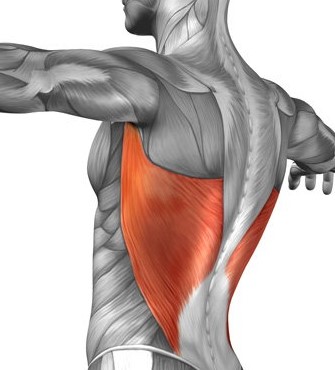I notice my dancers and fighters struggle to get their arms over their head. Most likely this is due to rounded, stooped posture of Parkinson’s. In addition to tight chest muscles, tight Latissimus dorsi “Lats” are most likely a culprit in this limited motion.
Latissimus dorsi means “broadest muscle of the back,” is one of the widest muscles in the human body. It is a very thin triangular muscle. It has many widespread origins and runs obliquely, superiorly and laterally through the back and armpits to insert on the back side of the upper arm. The lats also connect to the lumbar spine, and assist with lower back movements.

Nearly every movement of the shoulder/arm will involve your “lat” muscles.
The “lat” muscles have many functions:
- Adduction of the arm, which is used when doing a pull-up or when pulling a heavy object down from a shelf above your head.
- Extension of the arm, as in swinging the arm toward the back, like swinging your arms while walking and rowing exercises.
- Medially rotate the arm, moving the front of the arm towards the body’s midline. If you bend your elbow, this rotation brings your hand towards your chest, when folding your arms or placing your hand over your heart.
- Surprise! They play a role in the breathing process. They’re an “accessory breathing muscle”, and assist rib movements during both inhalation and exhalation.
Now, imagine if this huge muscle gets tight or bound down…Yikes! You won’t be able to straighten up evenly, lift your arms in the air, or rotate. This can cause a host of aches and pains in your shoulders, neck, back and can even make breathing difficult. Let’s fix this!
Watch the video below to learn how to roll out your lats for Parkinson’s tight shoulders:
-
- Lie face up on the floor with the foam roller placed in the middle part of your back. It should be parallel to your body.
- Cross your left leg over your right and place your left foot on the floor, and turn your torso 45 degrees to the right.

- Extend your lower arm out as much as you can. Use your left foot to push your body back and forth, running the roller up along the side of your upper back and under your armpit.
- When the roller is touching the back of your shoulder, stop. You can try rocking back and forth for extra release.
- With your elbow bent 90 degrees, move your arm around to help work out any knots you feel.
- Spend several minutes here and repeat on the other side.
- Repeat 2 times daily.
